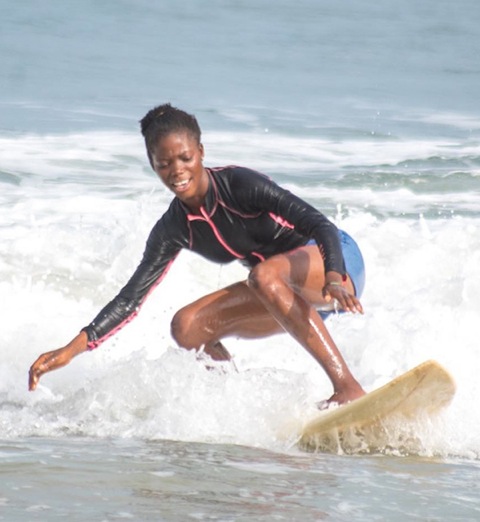Black Girls Surf trains young women around the world
By Shirley Hawkins
Contributing Writer
LOS ANGELES — Growing up in Kansas City, Missouri, and enduring the sweltering summer heat, Rhonda Harper became fascinated with watching the “Beach Blanket Bingo” movies where teenagers happily swam out into the ocean and hung 10 on their surfboards.
“They constantly ran the Beach Blanket Bingo and Gidget movies on TV,” Harper recalls. “I even remember Stevie Wonder singing and playing the harmonica in the “Muscle Beach Party” movie.
When her family moved to California when she was 10, Harper begged her parents to take her to the beach.
“As soon as I saw the beach, I fell in love, I was done,” Harper said. “I wanted to become a professional surfer, but there was nobody else around who looked like me. I did not see Black surfers and Black women in major competitions. So I needed to become the person that I needed for everybody else.”
After learning how to surf, Harper, a former U.S. Coast Guard member and fashion designer, founded Black Girls Surf in 2014 to attract more people of color to the sport. The nonprofit organization, which has branches in San Jose and Los Angeles, is a high-performing training camp that trains girls 11 to 17.
Today, Black Girls Surf Inc. is a global nonprofit organization that recruits girls in the U.S., Senegal, Jamaica, Brazil, Ghana, Kenya, Nigeria and Sierra Leone. It provides valuable training experience, youth exchange opportunities, video production, educational development, casting opportunities, mentorship and coaching, surf therapy and competition assistance.
With the Olympics in Tokyo currently in the headlines, Harper said that there are still barriers for surfers of color to break through.
“Black Africans who surf were not represented in the Olympics at all,” she said. “I think the system that they used to choose the surfers was unfair to everyone. Twenty of the spots went to surfing pros and all of the amateurs had to fight for their spots.”
Harper was disappointed that Black Girls Surf member 25-year-old Khadjou Sembe from Senegal, whom she brought to the states to help train, did not make the cut to compete.
“Believe it or not, the representative chosen from South Africa has blond hair and blue eyes,” Harper said.
While the Olympics continue in Tokyo, Harper is currently in Senegal where she is busy scouting and training girls for her organization.
“You’d be amazed at how many Black surfers there are worldwide,” she said.
She said that surfing has been in Africa for centuries, especially in Ghana.
“Peru and Ghana originated surfing, not Hawaii, like most people believe,” Harper said.
“Our main goal is to get more women to become professional surfers,” said the trailblazing Harper, who added that there are more than 400 teens around the world who are currently signed up with Black Girls Surf.
“One of the organization’s goals is to train the girls and get them certified so that they can enter competitions,” she said. “I also want to offer education and training to bring more camera people and surfing judges of color into the sport and get them working behind the scenes.”
Last year, as the country came to grips with the deaths of Breanna Taylor, George Floyd, Armaud Arberry and Vanessa Guillen, Black Girls Surf held a vigil for the slain victims to raise awareness for inequality in and out of the water.
“These paddle outs were peaceful protests for lives lost to police brutality and racism in America,” Harper said.
Participants paddled out into the waves at Inkwell Beach in Santa Monica, where they were given yellow roses. Then the crowd delivered a eulogy and a prayer for Taylor, Arberry, Floyd and Guillen before releasing the roses into the water.
Harper also placed a plaque at the entrance to Inkwell Beach, which was the only Southern California beach available to African Americans after the popular Bruce’s Beach was closed in 1924 due to segregation. The plaque pays tribute to Nicolas Rolando Gabaldon, who is credited by surfing experts with being California’s first documented surfer of African-American and Latino descent.
Harper said she is diligently working toward the day when people of color are fully accepted in the surfing world. “When you see a black person or black people come on the beach, it becomes a spectacle, it becomes an attraction,” she said. “There are times when I can’t get to my car without people wanting to take pictures of me and my surfboard because they have never seen a Black surfer before.”
Harper said that her trailblazing spirit was inspired by her parents, Linda and Nathaniel Harper, who were lifelong civil rights activists.
“They helped to desegregate schools in Kansas City, they fought against the incarceration of young people in juvenile hall and they marched in countless protests,” Harper recalls. “I’ve been a card-carrying member of the NAACP since I was 5 years old.
“When I saw the lack of people of color in the surfing world, I knew I had to do something,” added Harper, who was inspired by her parents and didn’t hesitate to roll up her sleeves and made it her mission to change the dynamic.
Harper said that it is gratifying to see kids who never thought that they could be a surfer stand up on a board for the first time.
“That’s a wonderful feeling,” she said, smiling.
As far as helping to break the barriers in the surfing world, Harper said simply,
“We just want to be seen and respected in the water just like everybody else.”
Shirley Hawkins is a freelance reporter for Wave Newspapers. She can be reached at metropressnews@gmail.com.











